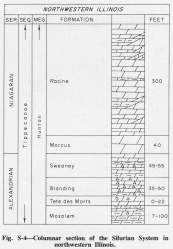Tete de Morts Formation
Lithostratigraphy: Hunton Limestone Megagroup >>Tete de Morts Formation
Chronostratigraphy: Paleozoic Erathem >>Silurian System >>Alexandrian Series
Allostratigraphy: Tippecanoe Sequence
Primary source
Willman, H. B., Elwood Atherton, T. C. Buschbach, Charles Collinson, John C. Frye, M. E. Hopkins, Jerry A. Lineback, and Jack A. Simon, 1975, Handbook of Illinois Stratigraphy: Illinois State Geological Survey Bulletin 95, 261 p.
Contributing author(s)
H. B. Willman and Elwood Atherton
Name
Original description
Tete des Morts Formation (Brown and Whitlow, 1960, p. 39).
Derivation
Named for Tete des Morts Creek, Dubuque County, Iowa.
Other names
History/background
The Tete des Morts Formation was originally designated a member of the Edgewood Formation but was later classified as a formation in Illinois (Willman, 1973, p. 33).
Type section
Type location
The type section of the Tete des Morts Formation is in the same exposure as the type section of the Mosalem Formation, in a roadcut south of the village of King (E1/2 SE 27, 88N-3E).
Type author(s)
Type status
Reference section
Reference location
Reference author(s)
Reference status
Stratigraphic relationships
The Tete des Morts overlies the Mosalem Formation in northwestern Illinois north of an east-west line through Hanover, Jo Daviess County (fig. S-4).
Extent and thickness
The Tete des Morts is about 24 feet thick in the type locality, but in Illinois it is commonly about 20 feet thick, with a range of 18-22 feet, except where it thins to absence within a short distance at its southern limit.
Lithology
The Tete de Morts Formation is the prominent cliff-forming unit at or near the top of many mounds and ridges in the Driftless Area in northwestern Illinois (fig. S-2D). The underlying Mosalem Formation and the Maquoketa Shale Group below are generally covered in the slopes below the Tete des Morts. The Tete des Morts Formation is mainly pure, fine-to medium-grained, vesicular, massive, gray dolomite in which corals, particularly Favosites, are common. It generally contains little chert, but a persistent band of chert nodules and chert lenses occurs in a thin, slightly argillaceous, well bedded zone 1-2 feet thick 7-8 feet below the top. Scattered chert nodules occur locally in the lower part of the formation, and thin vein-like lenses of white chert are common, particularly in the upper part. Glauconite is common to abundant in the upper part and common to rare in the lower part. Weathered surfaces are deeply etched and exceptionally rough.
Core(s)
Photograph(s)
Contacts
Well log characteristics
Fossils
Except for corals, fossils are scarce in the Tete des Morts Formation.
Age and correlation
The Tete des Morts most closely resembles the glauconitic Drummond Member at the base of the Kankakee Formation in northeastern Illinois, but if the nearly identical Elwood and Blanding Formations, which have conspicuous layers of chert, are equivalent, the Tete des Morts must be older than the Drummond, and it may be laterally equivalent to upper beds of the Wilhelmi Formation.
Environments of deposition
Economic importance
Remarks
References
BROWN, C. E., and J. W. WHITLOW, 1960, Geology of the Dubuque South Quadrangle, Iowa-Illinois: USGS Bulletin 1123-A, p. 1-93.
WILLMAN, H. B., 1973, Rock stratigraphy of the Silurian System in northeastern and northwestern Illinois: Illinois State Geological Survey Circular 479, 55 p.
ISGS Codes
| Stratigraphic Code | Geo Unit Designation |
|---|---|

